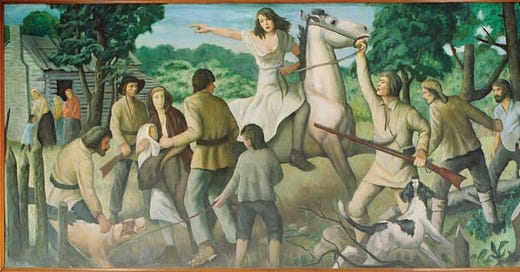TWIH: A female "Paul Revere"
Rachel Silverthorn has been called one of the Paul Reveres of the West Branch Valley in Pennsylvania.
At about this time in 1778, Rachel Silverthorn makes a daring ride. Tradition has it that she volunteered for her mission when no man would. She has been called one of the Paul Reveres of the West Branch Valley in Pennsylvania.
There were so many brave women who did amazing things during the American Revolution! Why do our history books teach us so little about them?
At the time, a tense situation existed on the Pennsylvania frontier. The British had allied themselves with local Indian tribes, so Indian attacks were becoming more and more frequent. On June 10, local settlers were shaken by the so-called Plum Tree Massacre: Sixteen settlers, including women and children, were attacked. Several were killed and scalped. That massacre soon was followed by a second on July 3.
The Indian tribes would later collect monetary rewards for 227 American scalps.
You won’t be surprised to hear that such events precipitated the so-called “Big Runaway” (or the “Great Runaway”). Settlers were fleeing the area in droves. Multiple “Paul Reveres” showed great bravery during this time. Remember, these attacks were occurring on the frontier, so news was not readily available. Settlers did not always know that their lives were in danger. Riders were needed to spread the news, and several people showed great bravery during this time.
One of these riders was a woman named Rachel Silverthorn. She had sought refuge in a local fort, Fort Muncy, but some men were still out in the field harvesting their crops, under the protection of soldiers and militia.
Importantly, a Captain John Brady was at the fort, not in the fields.
Trouble came on August 8: Some men were still out in the fields, harvesting crops, when they were attacked by Indian warriors. Captain Brady’s son was there and was unfortunately shot, stabbed with a spear, and scalped. A survivor quickly rode to Fort Muncy with the bad news. Obviously, other settlers in the area would need to be warned.
Can you imagine what it must have been like to stand in Captain Brady’s shoes? He had just received devastating news, but he still needed to lead those at the fort. “Brave soldier that he was,” one local historian writes, “he controlled his own anxiety and grief and thought of the safety of other harvesting bands that had gone from the fort that morning.”
He gathered the settlers and asked for a volunteer to ride, spreading word of the danger. He concluded with the thundering question, “Who will go on this errand of mercy?” At first, no one moved. The settlers were terrified! Of course they didn’t want to ride. Would they be riding to their death? It was at this moment that the young Silverthorn quietly volunteered. Reportedly, she sprang into the saddle of the captain’s horse and rode off before anyone could stop her.
Silverthorn accomplished her task. She warned the families in the area, who traveled to the safety of Fort Muncy. She herself made it back to the fort by nightfall, unharmed.
Wow. What a brave act. And what a girl.
Sources can always be found on my website, here.
For an alternative view on the use of the phrase “Native American” versus “Indian” or “American Indian,” please see this piece.





Great story Tara. Thank you!
Bravery doesn't know Gender, does it?
Unfortunately our school system today does not teach enough American History, much less tell all these untold stories.